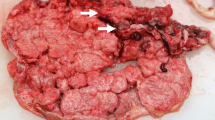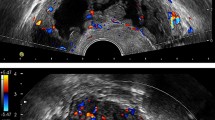Abstract
Previously, we reported endometriotic-like decidual lesions in contact with the fetal membranes (FMs) in 11 pregnant women with severe endometriosis. In this report, an extensive histomorphological analysis was performed on the FMs of 19 pregnant women with deep infiltrating endometriosis (DIE) at term pregnancy and who delivered by cesarean delivery before labor. On gross examination, all samples showed increased thickness, de novo microvessel formation, and small-size excrescences distributed along the membrane circumference. Histological examination of FM fragments sampled from the placenta edges or from the cesarean incision line showed fibrinoid necrosis and connective tissue accumulation in the amnion, chorion, and decidual layers in most of the 19 women with DIE. Papillary tufting and epithelial cell multilayering at the surface of the amnion layer were found in 3 of the 19 women with DIE. In 14 of the 19 women with DIE, the trophoblastic layer was disrupted by dense extracellular material, degenerative villi, and inflammatory infiltrates. Cystic gland-like structures were found in the decidual layer in all the 19 women with DIE, which were surrounded by irradiating small vessels and scattered inflammatory cells. The relationship between these peculiar histological changes and the endometriotic status of the pregnant women is still unclear. Sustained examination of FMs in women with DIE is needed to fully evaluate the defaults in these tissue structures and to establish whether these defaults have clinical impact on the pregnancy course.
Similar content being viewed by others
References
Bulletti C, Coccia ME, Battistoni S, Borini A. Endometriosis and infertility. J Assist Reprod Genet. 2010;27(8):441–447.
Brosens I, Pijnenborg R, Benagiano G. Defective myometrial spiral artery remodelling as a cause of major obstetrical syndromes in endometriosis and adenomyosis. Placenta. 2013; 34(2): 100–105.
Noble LS, Simpson ER, Johns A, Bulun SE. Aromatase expression in endometriosis. J Clin Endocrinol Metab. 1996;81(1): 174–179.
Bulmer JN, Jones RK, Searle RF. Intraepithelial leukocytes in endometriosis and adenomyosis: comparison of eutopic and ectopic endometrium with normal endometrium. Hum Reprod. 1998; 13(10):2910–2915.
Tseng JF, Ryan IP, Milam TD, et al. Interleukin-6 secretion in vitro is up-regulated in ectopic and eutopic endometrial stromal cells from women with endometriosis. J Clin Endocrinol Metab. 1996;81(3):1118–1122.
Taylor HS, Bagot C, Kardana A, Olive D, Arici A. HOX gene expression is altered in the endometrium of women with endome-triosis. Hum Reprod. 1999;14(5):1328–1331.
Dmowski WP, Steele RW, Baker GF. Deficient cellular immunity in endometriosis. Am J Obstet Gynecol. 1981;141(4):377–383.
Benaglia L, Bermejo A, Somigliana E, et al. Pregnancy outcome in women with endometriomas achieving pregnancy through IVF. Hum Reprod. 2012;27(6):1663–1667.
Fernando S, Breheny S, Jaques AM, Halliday JL, Baker G, Healy D. Preterm birth, ovarian endometriomata, and assisted reproduction technologies. Fertil Steril. 2009;91(2):325–330.
Kortelahti M, Anttila MA, Hippelainen MI, Heinonen ST. Obstetric outcome in women with endometriosis—a matched case-control study. Gynecol Obstet Invest. 2003;56(4):207–212.
Stephansson O, Kieler H, Granath F, Falconer H. Endometriosis, assisted reproduction technology, and risk of adverse pregnancy outcome. Hum Reprod. 2009;24(9):2341–2347.
Vercellini P, Parazzini F, Pietropaolo G, Cipriani S, Frattaruolo M, Fedele L. Pregnancy outcome in women with peritoneal, ovar-ian and rectovaginal endometriosis: a retrospective cohort study. Bjog. 2012;119(12):1538–1543.
Marcellin L, Santulli P, Gogusev J, et al. Endometriosis also affects the decidua in contact with the fetal membranes during pregnancy. Hum Reprod. 2015;30(2):392–405.
Koninckx PR, Martin DC. Deep endometriosis: a consequence of infiltration or retraction or possibly adenomyosis externa? Fertil Steril. 1992;58(5):924–928.
Abrao MS, Goncalves MO, Dias JA Jr, Podgaec S, Chamie LP, Blasbalg R. Comparison between clinical examination, transvagi-nal sonography and magnetic resonance imaging for the diagnosis of deep endometriosis. Hum Reprod. 2007;22(12):3092–3097.
Bazot M, Lafont C, Rouzier R, Roseau G, Thomassin-Naggara I, Dara’i E. Diagnostic accuracy of physical examination, transvaginal sonography, rectal endoscopic sonography, and magnetic resonance imaging to diagnose deep infiltrating endometriosis. Fertil Steril. 2009;92(6):1825–1833.
Nisenblat V, Prentice L, Bossuyt PM, Farquhar C, Hull ML, Johnson N. Combination of the non-invasive tests for the diagnosis of endometriosis. Cochrane Database Syst Rev. 2016;(7): CD012281.
Malak TM, Bell SC. Structural characteristics of term human fetal membranes: a novel zone of extreme morphological alteration within the rupture site. Br J Obstet Gynaecol. 1994;101(5):375–386.
McLaren J, Malak TM, Bell SC. Structural characteristics of term human fetal membranes prior to labour: identification of an area of altered morphology overlying the cervix. Hum Reprod. 1999; 14(1):237–241.
Marcellin L, Schmitz T, Messaoudene M, et al. Immune modifi-cations in fetal membranes overlying the cervix precede parturition in humans. J Immunol. 2017;198(3):1345–1356.
Bourne G. The foetal membranes. A review of the anatomy of normal amnion and chorion and some aspects of their function. Postgrad Med J. 1962;38:193-201.
Hecht JL, Zsengeller ZK, Spiel M, Karumanchi SA, Rosen S. Revisiting decidual vasculopathy. Placenta. 2016;42:37-43.
Haugh AM, Witt JG, Hauch A, et al. Amnion membrane in dia-betic foot wounds: a meta-analysis. Plast Reconstr Surg Glob Open. 2017;5(4):e1302.
Silini AR, Cargnoni A, Magatti M, Pianta S, Parolini O. The long path of human placenta, and its derivatives, in regenerative medicine. Front Bioeng Biotechnol. 2015;3:162.
Author information
Authors and Affiliations
Corresponding author
Rights and permissions
About this article
Cite this article
Marcellin, L., Méhats, C. & Gogusev, J. Histopathological Alterations in Fetal Membranes of Women With Endometriosis. Reprod. Sci. 25, 782–787 (2018). https://doi.org/10.1177/1933719117728804
Published:
Issue Date:
DOI: https://doi.org/10.1177/1933719117728804




